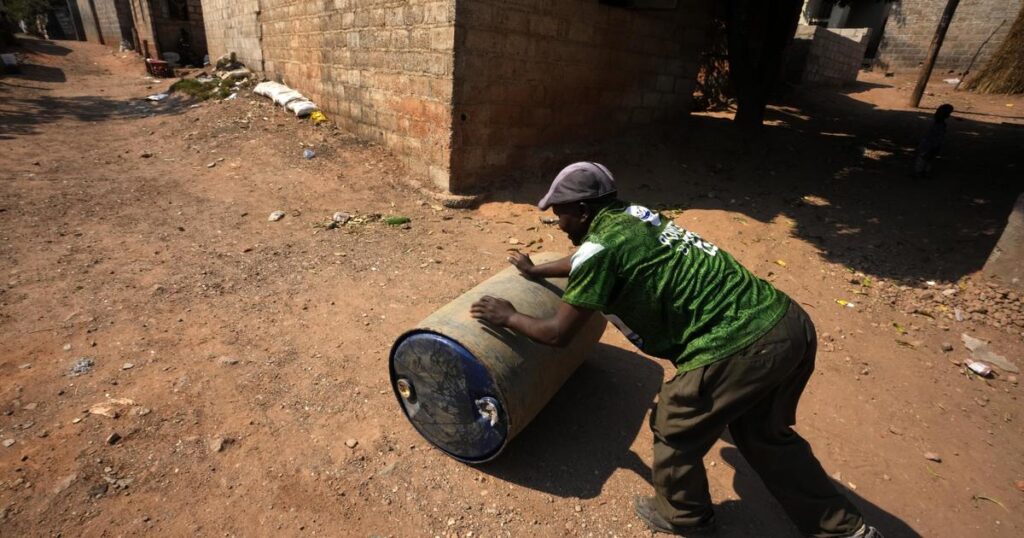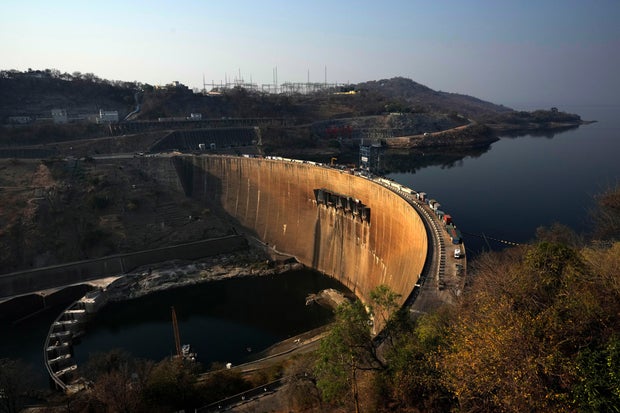Tyndall Sikhnyongana is trying to run a welding business, but these days that means buying a diesel generator, which uses expensive fuel he can’t usually afford.
Like everyone in Zambia, Sikunyongana is struggling daily to find and provide electricity during the disaster. Energy crisis due to climate change It stripped the southern African country of nearly all power.
“God knows when this crisis will end,” Sikhnyongana said. His generator ran out of diesel and came crashing to a halt as he spoke. “Do you understand what I mean?” he said.
Themba Hadebe / AP
What is the cause of the power outage in Zambia?
Zambia’s worst power outage in memory was caused by a severe disaster. drought In the region, the key Kariba dam, the root of Sikhnyongana’s woes, remains without enough water to power its hydroelectric turbines. Kariba is the world’s largest man-made lake by volume, located 200 kilometers (125 miles) south of Lusaka on the Zambia-Zimbabwe border.
The massive dam wall was built in the 1950s and more than 80 workers died during its construction. The plan was to revolutionize the nation’s energy supply by trapping the Zambezi River’s water, turning the valley into a giant lake, and providing an endless supply of renewable hydroelectric power.
That is no longer the case due to months of naturally occurring drought. El Niño weather pattern Exacerbated by rising temperatures, Zambia’s hydropower plants are on the brink of complete shutdown for the first time.
Water levels are so low that only one of the six turbines on the Zambian side of the dam is operational, reducing power generation to less than 10% of normal. Zambia relies on Kariba for more than 80% of its national electricity supply, resulting in Zambians having access to electricity for only a few hours a day at the best of times. Power outages will continue for several days in many areas.
Edra Musonda was furious and decided to take her entire desktop computer (hard drive, monitor and everything) to a local cafe to do some work.
Musonda and others flock to Mercato Cafe in Zambia’s capital, Lusaka, not for the sandwiches or the atmosphere, but because it has a diesel generator. Tables are cluttered with power strips and cables as people connect to their phones, laptops and, in Musonda’s case, home offices. This is the only way her small travel business will survive.
Before the Kariba crisis, less than half of Zambia’s 20 million people had access to electricity. Millions more are being forced to adapt as mothers find different ways to cook for their families and children do their homework by candlelight. The most harmful impact will be during Japan and China, when small and medium-sized businesses, the backbone of the country, are struggling to survive.
“This will also increase the level of poverty in the country,” said economist Trevor Hanbay, who fears that Zambia’s economy could contract significantly if the electricity crisis continues. This is a warning to the Zambian government and the continent in general about the dangers to development of relying heavily on a single climate-dependent energy source.
Climate change and extreme weather
The power crisis is a bigger blow to the economy and the fight against poverty than the lockdown. COVID-19 (new coronavirus infection) Zambia Manufacturers Association President Ashu Sagar spoke about the pandemic.
Africa has the least impact on global warming, but it is the continent most vulnerable to extreme weather events and disasters. climate change This is because poor countries cannot afford the high fiscal costs of adaptation. This year’s drought in southern Africa is the worst in decades, with crops dying and millions going hungry, prompting countries such as Zambia to declare a national disaster and call for aid.
According to the International Energy Agency, hydropower accounts for 17% of Africa’s energy generation, but that figure is expected to rise to 23% by 2040. Zambia is not alone in Mozambique, Malawi, Uganda, Ethiopia and Congo, where hydropower accounts for more than 80% of their energy mix, and where experts warn hydropower will become even less reliable.
Carlos Lopez, a professor at the Mandela School of Public Governance at the University of Cape Town in South Africa, said: “Extreme weather patterns such as prolonged droughts make it clear that over-reliance on hydropower is no longer sustainable.” .
The Zambian government is encouraging citizens and businesses to install solar power generation. But while many Zambians cannot afford this technology, the government itself is turning to more familiar but polluting diesel generators to temporarily power hospitals and other buildings. is facing. He also said he would increase electricity from coal-fired power plants as needed. Neighboring Zimbabwe, which has also lost much of its power generation from Kariba and suffers frequent power outages, gets most of its electricity from coal-fired power plants.
Themba Hadebe / AP
Changes in Kariba Dam
At Kariba, the 128 meter (420 ft) high dam wall is almost completely exposed. A dry reddish-brown stain near the top marks where water once reached in better days more than a decade ago.
Leonard Siambotu, who has been taking tourists on boat cruises on the picturesque lake for more than 20 years, has seen the change. As the water level receded, it exposed old, dead trees that had been completely submerged for years after the wall was built. “This is the first time I’ve seen this tree,” he said of the tree that appeared in the middle of the lake.
The lake’s water level naturally rises and falls depending on the season, but typically rises by about 6 meters after rain. Officials said the fluctuation was less than 30 centimeters after last year’s rainy season almost didn’t materialize. They are hoping for rain this year, which is supposed to start in November. But they estimate it will still take three years for Kariba’s hydropower capacity to be fully restored.
Experts say there is no guarantee that such rain will come, and given that Zambia has experienced power problems due to drought before, and the trend is getting worse, it is unlikely that this will depend on climate change. He says it’s dangerous.
“It’s not a solution…just sit back and wait for nature,” Hanbay said.





